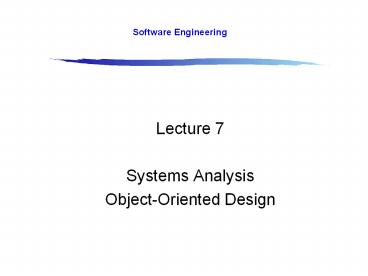Systems Analysis - PowerPoint PPT Presentation
Title:
Systems Analysis
Description:
Title: Lecture 7 Last modified by: Barbara Hecker Created Date: 9/28/2000 7:34:01 PM Document presentation format: On-screen Show Other titles: Times New Roman Arial ... – PowerPoint PPT presentation
Number of Views:96
Avg rating:3.0/5.0
Title: Systems Analysis
1
Software Engineering
- Lecture 7
- Systems Analysis
- Object-Oriented Design
2
Project Work
- Requirements Document ? Done!
- Perform Systems Analysis
- Create Analysis Document
- Create Design Document
- Create Prototype
- Project Done!
3
Analysis Specification Document
- Page 46 of the Class Notes
- The Analysis Document Contains
- 1. Introduction section
- Specific Project Objectives
- Overall Requirements Description
- Project Constraints and Assumptions
- 2. Functional Requirements
- ERD
- DFD
- Process Descriptions
- Design Specification Description
- Performance and Reliability Requirements
- UML Diagrams (Component Diagrams)
- Test Plan
4
Structure Analysis Phase
- Previously Covered
- Entity Relations shown in ERD format
- Data Flow shown in DFD format
- Data, Actions and Entities are separated for
clarity
5
Structure Analysis vs. Object-Oriented Design
- Object Oriented Analysis and Design
- Uses Structured Analysis
- Uses visual representation similar to Structured
Analysis - Diagramming builds from ERD and DFD concepts
- Easy to learn
- UML standards use common sense
6
Object-Oriented Analysis Phase
- Object-Oriented Design Methodology
- Reaction to perceived shortcomings in structured
analysis - The problem of larger products
- Data and action are treated as equal partners
7
Object-Oriented Analysis
- Object consists of
- Data (attributes, state variables, instance
variables, fields, data members), and - Actions (methods, member functions)
- Objects are independent units
- Conceptual independence
- Physical independence
8
Different OO Methods
- Many different methods exist
- Booch
- OMT
- Objectory
- Shlaer-Mellor
- Coad-Yourdon
- All are essentially equivalent
- Nowadays, we represent OOA using UML (Unified
Modeling Language)
9
The Three Steps of OOA
- 1. Use-case modeling
- Determine how the various results are computed by
the product (without regard to sequencing) - Largely action-oriented
- 2. Class modeling (object modeling)
- Determine the classes and their attributes
- Purely data-oriented
- 3. Dynamic modeling
- Determine the actions performed by or to each
class - Purely action-oriented
- The process is iterative
10
Elevator Problem OOA
- 1. Use-Case Modeling
- Use case Generic description of overall
functionality - Scenario Instance of a use case
- Get comprehensive insight into behavior of product
11
Use CASE Scenario
12
Class Modeling
- Extract classes and their attributes
- Represent them using an entity-relationship
diagram - Deduce the classes from use cases and their
scenarios - Often there are many scenarios
13
Two Approaches to Class Modeling
- Noun extraction
- Always works
- CRC cards
- Need to have domain expertise
14
Noun Extraction
- Concise Problem Definition
- Define product in single sentence
- Buttons in elevators and on the floors control
the motion of n elevators in a building with m
floors.
15
Noun Extraction
- Identify nouns in the informal strategy
- Nouns
- button, elevator, floor, movement, building,
illumination, request, door - floor, building, door are outside problem
boundary exclude - movement, illumination, request are abstract
nouns exclude (they may become attributes) - Create classes Elevator and Button
16
First Iteration of Class Diagram
- Problem
- Buttons do not communicate directly with
elevators - We need an additional class Elevator Controller
17
Second Iteration of Class Diagram
18
Third Iteration of Class Diagram
19
Why is Iteration Needed?
- Perhaps the method is not yet mature?
- Waterfall model (explicit feedback loops)
- Rapid prototyping model (aim to reduce
iteration) - Incremental model (explicit iterative approach)
- Spiral model (explicit iterative approach)
- Iteration is a property of all software
production - Especially for medium- and large-scale products
- Expect iteration in the object-oriented paradigm
20
CRC Cards
- Used since 1989 for OOA
- For each class, fill in card showing
- Name of Class
- Functionality (Responsibility)
- List of classes it invokes (Collaboration)
- Strength
- When acted out by team members, CRC cards are a
powerful tool for highlighting missing or
incorrect items - Weakness
- Domain expertise is needed
21
Example CRC Cards
22
Dynamic Modeling
- Produce UML state diagram
- State, event, predicate are distributed over the
state diagram
23
State Diagram
24
Modeling Tools
- SmartDraw, 30-day trial version is available for
FREE http//www.smartdraw.com/ - Microsoft Visio
- System Architect
- CASE Tools
- Many other drawing tool
25
SmartDraw Software Design Option
26
SmartDraw Components Symbols
27
Project Work
- Work in your teams to create your Analysis
Document - Next time we will discuss UML and OOD in more
detail.































